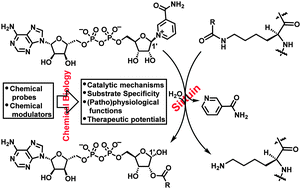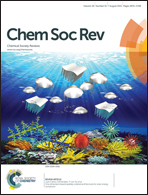The chemical biology of sirtuins
Abstract
The sirtuin family of enzymes are able to catalyze the Nε-acyl-lysine deacylation reaction on histone and non-histone protein substrates. Over the past years since the discovery of its founding member (i.e. the yeast silent information regulator 2 (sir2) protein) in 2000, the sirtuin-catalyzed deacylation reaction has been demonstrated to play an important regulatory role in multiple crucial cellular processes such as transcription, DNA damage repair, and metabolism. This reaction has also been regarded as a current therapeutic target for human diseases such as cancer, and metabolic and neurodegenerative diseases. The unique β-nicotinamide adenine dinucleotide (β-NAD+ or NAD+)-dependent nature of the sirtuin-catalyzed deacylation reaction has also engendered extensive mechanistic studies, resulting in a mechanistic view of the enzyme chemistry supported by several lines of experimental evidence. On the journey toward these knowledge advances, chemical biological means have constituted an important functional arsenal; technically, a variety of chemical probes and modulators (inhibitors and activators) have been developed and some of them have been employed toward an enhanced mechanistic and functional (pharmacological) understanding of the sirtuin-catalyzed deacylation reaction. On the other hand, an enhanced mechanistic understanding has also facilitated the development of a variety of chemical probes and modulators. This article will review the tremendous accomplishments achieved during the past few years in the field of sirtuin chemical biology. It is hoped that this would also help to set a stage for how outstanding mechanistic and functional questions for the sirtuin-catalyzed deacylation reaction could be addressed in the future from the chemical biology perspective.



 Please wait while we load your content...
Please wait while we load your content...